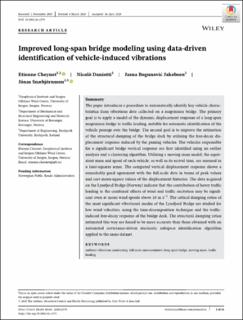| dc.contributor.author | Cheynet, Etienne | |
| dc.contributor.author | Daniotti, Nicolo | |
| dc.contributor.author | Jakobsen, Jasna Bogunovic | |
| dc.contributor.author | Snæbjörnsson, Jonas Thor | |
| dc.date.accessioned | 2023-01-10T12:56:04Z | |
| dc.date.available | 2023-01-10T12:56:04Z | |
| dc.date.created | 2020-05-29T15:01:30Z | |
| dc.date.issued | 2020 | |
| dc.identifier.citation | Cheynet, E., Daniotti, N., Jakobsen, J. B., & Snæbjörnsson, J. (2020). Improved long‐span bridge modeling using data‐driven identification of vehicle‐induced vibrations. Structural Control and Health Monitoring, 27(9), e2574. | en_US |
| dc.identifier.issn | 1545-2255 | |
| dc.identifier.uri | https://hdl.handle.net/11250/3042350 | |
| dc.description.abstract | The paper introduces a procedure to automatically identify key vehicle charac-teristics from vibrations data collected on a suspension bridge. The primarygoal is to apply a model of the dynamic displacement response of a long-spansuspension bridge to traffic loading, suitable for automatic identification of thevehicle passage over the bridge. The second goal is to improve the estimationof the structural damping of the bridge deck by utilizing the free-decay dis-placement response induced by the passing vehicles. The vehicles responsiblefor a significant bridge vertical response are first identified using an outlieranalysis and a clustering algorithm. Utilizing a moving mass model, the equiv-alent mass and speed of each vehicle, as well as its arrival time, are assessed ina least-squares sense. The computed vertical displacement response shows aremarkably good agreement with the full-scale data in terms of peak valuesand root-mean-square values of the displacement histories. The data acquiredon the Lysefjord Bridge (Norway) indicate that the contribution of heavy trafficloading to the combined effects of wind and traffic excitation may be signifi-cant even at mean wind speeds above 10 m s−1. The critical damping ratios ofthe most significant vibrational modes of the Lysefjord Bridge are studied forlow wind velocities, using the time-decomposition technique and the traffic-induced free-decay response of the bridge deck. The structural damping ratiosestimated this way are found to be more accurate than those obtained with anautomated covariance-driven stochastic subspace identification algorithm applied to the same dataset. | en_US |
| dc.language.iso | eng | en_US |
| dc.publisher | John Wiley & Sons | en_US |
| dc.rights | Navngivelse 4.0 Internasjonal | * |
| dc.rights.uri | http://creativecommons.org/licenses/by/4.0/deed.no | * |
| dc.title | Improved long-span bridge modeling using data-driven identification of vehicle-induced vibrations | en_US |
| dc.type | Peer reviewed | en_US |
| dc.type | Journal article | en_US |
| dc.description.version | publishedVersion | en_US |
| dc.rights.holder | the authors | en_US |
| dc.subject.nsi | VDP::Bygg-, anleggs- og transportteknologi: 532 | en_US |
| dc.subject.nsi | VDP::Building, construction and transport technology: 532 | en_US |
| dc.source.volume | 27 | en_US |
| dc.source.journal | Structural Control and Health Monitoring: The Bulletin of ACS | en_US |
| dc.source.issue | 9 | en_US |
| dc.identifier.doi | 10.1002/stc.2574 | |
| dc.identifier.cristin | 1813267 | |
| dc.source.articlenumber | e2574 | en_US |
| cristin.ispublished | true | |
| cristin.fulltext | original | |
| cristin.fulltext | original | |
| cristin.qualitycode | 1 | |

